Parkinson's Disease: Vitamins, Supplements and Diet:
Parkinson's does not have a single cause or an exact symptom for all patients and thus there is no single approach to treatment. Options are presented below that can be used to tailor an individual treatment. One of the most common symptoms of Parkinson's disease is constipation. Luckily constipation is easily treatable with laxatives or by adding more fiber to one's diet. Some vitamins and supplements target mental cognition (vitamin B6, B12), some support liver detox (Calcium D-Glucarate and Glycine) and toxic heavy metal detox (NAC and Glycine). Some help combat vascular Parkinson's disease such as omega-3, niacin and aspirin. There are also vitamins and supplements which research has shown to support the battle with Parkinson's such as Nicotinamide riboside, vitamin D and Magnesium.
Probiotics and changing eating intervals to induce autophagy can also be helpful for Parkinson's patients. Research has also shown that a ketogenic diet is helpful for both Parkinson's and Alzheimer's disease for non-motor symptoms. There are strong ties between the protein NLRP3, inflammation, alpha-synuclein and Parkinson's. There are supplements and foods that have inhibitory effects on this NLRP3 pathway. Research has also found various vitamins and supplements to be beneficial for Parkinson's patients as noted below.
Certifications and Quality:
Producers of dietary vitamins and supplements are known to be of higher quality and consistency if manufactured to third party verified standards.
- CGMP: Current Good Manufacturing Practice regulations are enforced by the FDA to assure proper design, monitoring, and control of manufacturing processes and facilities.
This includes establishing strong quality management systems, obtaining appropriate quality raw materials, establishing robust operating procedures, detecting and investigating product quality deviations, and maintaining reliable testing laboratories to insure pharmaceutical quality.
FDA: Facts About the Current Good Manufacturing Practices - ConsumerLab.com: comparative study of supplements and nutritional products
ConsumerLab.com - NSF International: certifying and testing. Performs audits of a company’s production sites to confirm they are following Good Manufacturing Practices (GMPs).
Certification NSF/ANSI 173 for content and labeling.
NSF.org - UL: quality assurance solutions, regulatory compliance testing, and global market access programs, to meet consumer and regulatory demands for high-quality dietary supplements.
UL.com - U.S. Pharmacopedia: provides support to manufacturers to help ensure the quality of dietary supplements.
USP.org
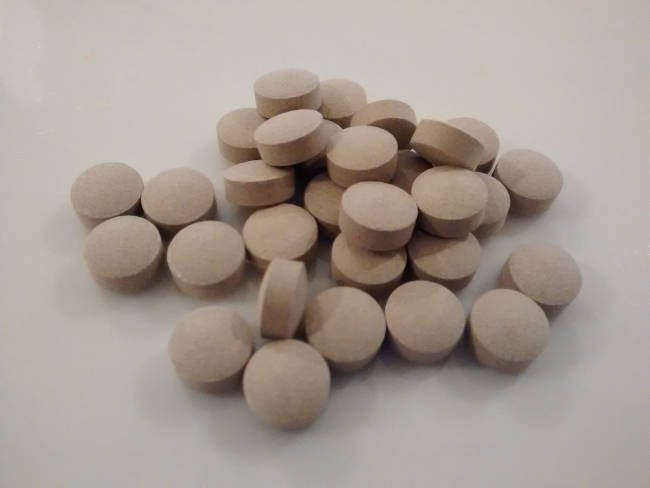
Constipation Remedies:
Parkinson's disease (PD) is known to affect the muscles and nerves which control the digestive process thus impacting gastrointestinal mobility defined medically as "gastroparesis". Gastro-intestinal dysfunctions characterized by constipation affect almost 80% of PD patients (ref). If one has fewer than three bowel movements per week, one should consider a treatment for constipation. This is also true if the stool does not pass easily or is not moist and soft. There should be no discomfort, pain or blood associated with a bowel movement. Consider the following steps to relieve constipation:
- Drink more water: Dehydration can make you constipated or make the stool hard and dry resulting is discomfort.
Also see Mild dehydration: a risk factor of constipation? - Exercise more: While the evidence is mixed, it is thought that exercise moves the body and colon allowing for improved stool movement.
- Consume more fiber: Fiber allows the stool to hold more moisture and improves the consistency of excrement. This includes oat bran, barley, nuts, seeds, beans, lentils, peas and fruits (especially prunes).
- Fiber Suplements: allow one to retain more water in the stool and act as a natural laxitive. Meta Mucil shown here contains Psyllium husk in a gelatin capsule. Other fiber materials include polycarbophil and methylcellulose.
- Laxitives: if none of the above are effective, see a doctor about stronger or prescription laxitives.
- Chloride Channel Activators: induces the intestines to secrete fluid to help the flow of the stool.
- Guanylate cyclase-C (GC-C) Agonists: also induce the intestines to secrete fluid to help the flow of the stool.
- Lubricants: allow the stool to pass through the intestines more easily. Example: mineral oil.
- Osmotic and Hyperosmotic Laxatives: balance the water concentration in the bowel through osmosis.
- Stimulant laxatives: accelerates the speed at which the stool moves through the colon.
- Stool softeners: allow the stool to absorb more fiber. eg Docusate Sodium (Col-Rite, Colace, Correctol, Diocto, Doc-Q-Lace, Docusoft, DSS, Silace, Surfak)
If these remedies do not help, see your doctor. If you are experiencing a high degree of pain or any blood in your stool, also see your doctor. Other much more serious ailments are possible causes.
Refereneces:
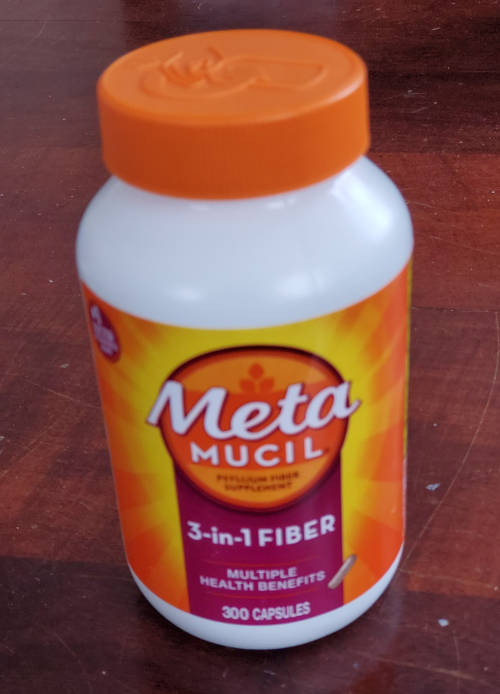
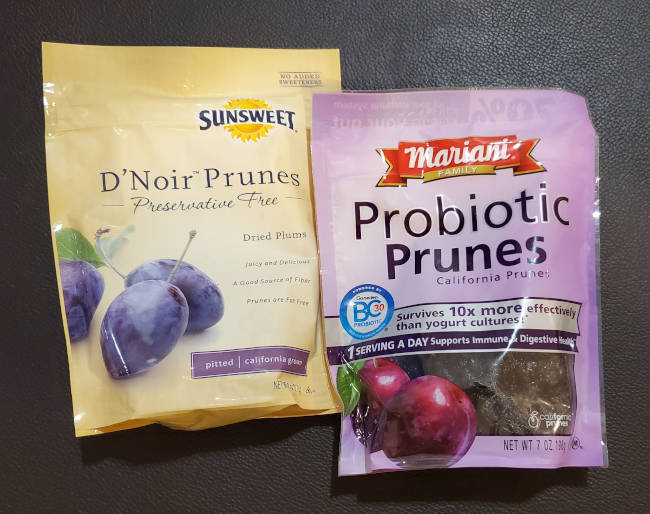
Prunes - nature's laxitive
Vitamin B1 (Thiamine):
Also known as Thiamine, vitamin B1 has been studied as a potential benefit for Parkinson's disease. Studies have suggested a theoretical benefit but unfortunately the research has not shown convincing efficacy (no placebo group), but the efforts are applauded.
Thiamine is not produced by the human body and thus it is generally obtained in ample quantity from food. Foods containing thiamine include seaweed (spirulina), sunflower seeds, macadamia nuts, peas, beans, asparagus and some whole grains.
References:- An open-label pilot study with high-dose thiamine in Parkinson's disease Constantini and Fancellu, 2016)
"In conclusion, we found that the long-term treatment with the intramuscular administration of thiamine has led to a significant improvement of motor and non-motor symptoms of the patients with PD; this improvement was stable during time and without side effects."
"further experience is necessary to exclude the placebo effect and to confirm the present observation, with clinical, cellular, and molecular data" - The Beneficial Role of Thiamine in Parkinson Disease (Luong and Nguyen, 2013)
"Thiamine plays a beneficial role in PD by inducing dopamine release and improving the symptoms associated with PD."
"further studies are needed to determine the potential benefits of using thiamine as a treatment for PD."
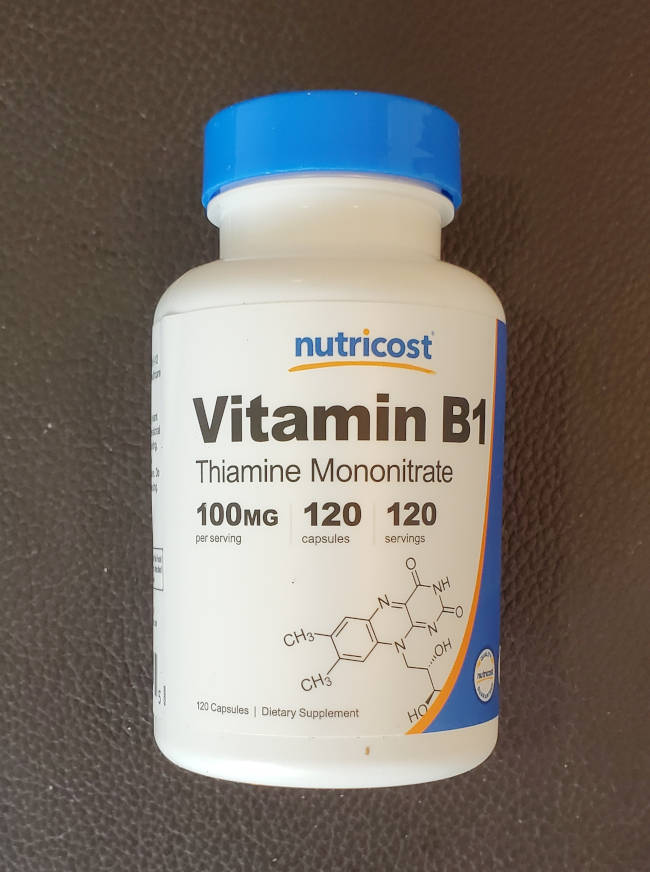
Vitamin B3 (Niacin):
There are so many forms associated with this vitamin it can get confusing fast. There are three forms of vitamin B3: niacin, nicotinamide, and nicotinamide riboside. Vitamin B3 is most often associated with niacin and can be often found in multi-vitamins and enriched flour and derived products. Nicotinamide, sometimes known as niacinamide, has a different molecular structure than niacin and avoids the flushing associated with niacin. Nicotinamide riboside is a precursor to the NAD+ vitamin and NAD-deficiency is a key-event in the pathogenesis of Parkinson's Disease as it leads to mitochondrial dysfunction leading to impaired neuronal metabolism. NAD+ also helps combat oxidative stress.
Niacin is not produced by the human body and thus it is generally obtained in ample quantity from food. Foods containing niacin include liver (beef or chicken), chicken breast, turkey, salmon, pork, avocado, green peas, mushrooms and potatoes.
Niacin has been shown to reduce neuroinflammation which is believed to play an active role in Parkinson's disease.
References:- Niacin Ameliorates Neuro-Inflammation in Parkinson’s Disease via GPR109A (Giri et al, 2019)
"Niacin triggers and boosts anti-inflammatory immune responses in humans and animal models of PD"
"Niacin may reduce neuroinflammation through the G-protein-coupled receptor, GPR109A, which has been noted to be up-regulated in PD patients"
"Here our results suggest that niacin may reduce PD symptoms and have beneficial effects on subjects through interaction with anti-inflammatory receptor, GPR109A."
Clinical Trails:
- NCT03808961 (2020)
Niacin for Parkinsons Disease (NAPS) study to examine the blood, urine and spinal fluid of persons with Parkinson's to look for evidence of inflammation and whether vitamin B3 (niacin or niacinamide) supplementation may reduce the inflammation and/or improve Parkinson's Disease motor and non-motor symptoms.
Institution: VA Office of Research and Development - NCT03462680 completed (2020)
Study to examine the blood, urine and spinal fluid of persons with Parkinson's to look for evidence of inflammation and whether vitamin B3 supplementation may reduce the inflammation and/or improve symptoms.
Institution: VA Office of Research and Development - NCT03568968 (2020)
Nicotinamide Riboside (1000 mg dose) Supplementation in Early Parkinson's Disease (NOPARK)
Institution: Haukeland University Hospital - NCT03816020 (2020)
NAD-supplementation (Nicotinamide Riboside 500 mg dose) in Drug naive Parkinson's Disease (NAD-PARK)
Institution: Haukeland University Hospital
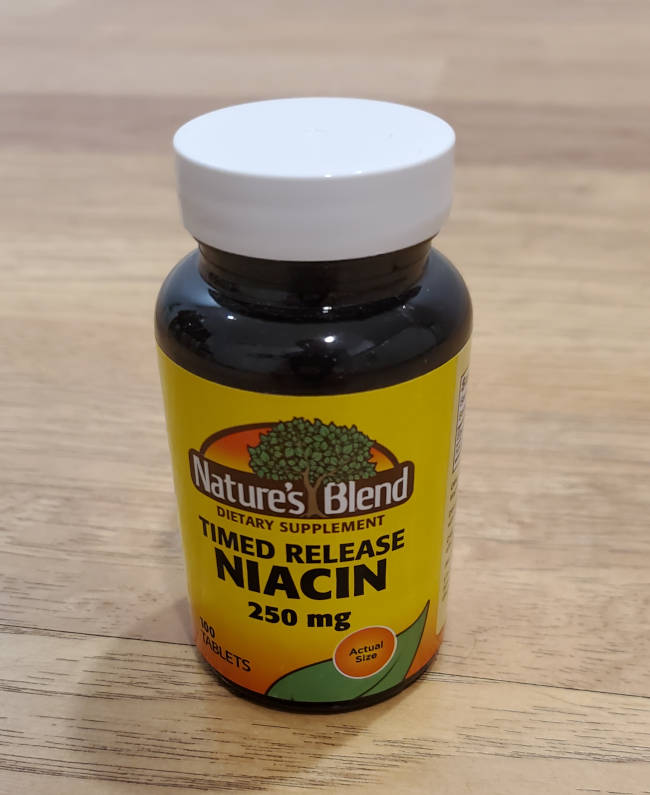
Vitamin B12:
Vitamin B12 is required by the body for red blood cell production, DNA formation, nerve function, and metabolism. Vitamin B12 has also been shown to have correlation to dementia for both Parkinson's and Alzheimer's diseases. The results of a study concluded that one's vitamin B12 blood levels aught to be more than 587 ng/L (nanograms per Liter) for only an 11% chance of developing dementia. Those with less than 587 ng/L vitamin B12 level had a 50% chance of having dementia within 5 years of a Parkinson's diagnosis. This is especially important for those on levodopa treatment which has been associated with lower levels of vitamin B12.
Vitamin B12 (along with vitamin B6 and folic acid) has been shown to improve cognition, lower oxidative stress and lower homocysteine levels, a known inflammation marker linked to Parkinson's disease and other movement disorders. Also see Inflammation and Parkinson's: homocysteine
The adult recommended daily intake (RDI) for vitamin B12 is 2.4 mcg (micrograms). Absorbption is typically 10 mcg per 500 mcg of supplement.
Warning: not to be used without professional medical supervision by those who have Leber disease, megaloblastic anemia, polycythemia vera, an alergy to cobalt or cobalamin or by those who have recently received a coronary stent (WebMD)
Reference: Possible Link Found Between Vitamin B12 Levels and Dementia in Parkinson's
Foods with high levels of vitamin B12 include:
| Food | Serving Size | % Recommended Daily Intake |
|---|---|---|
| Liver and kidneys (lamb, beef, veal) | 100 g | 3,000+ % |
| Clams | 100 g | 4,000 % |
| Sardines | 150 g | 500 % |
| Beef | 100 g | 245 % |
| Fortified cereal | 50 g | 50+ % |
| Trout | 100 g | 300 % |
| Salmon | 175 g | 200 % |
| Milk | 240 ml | 46 % |
| One Egg | 50 g | 25 % |
Thus four, 50 gram eggs, would be required to achieve the Recommended Daily Intake of vitamin B12.
The recommended daily intake of vitamin B12 is at least 6 mcg. Measured levels of vitamin B12 in blood are healthy when in the range of 587 to 1245 pg/mL.
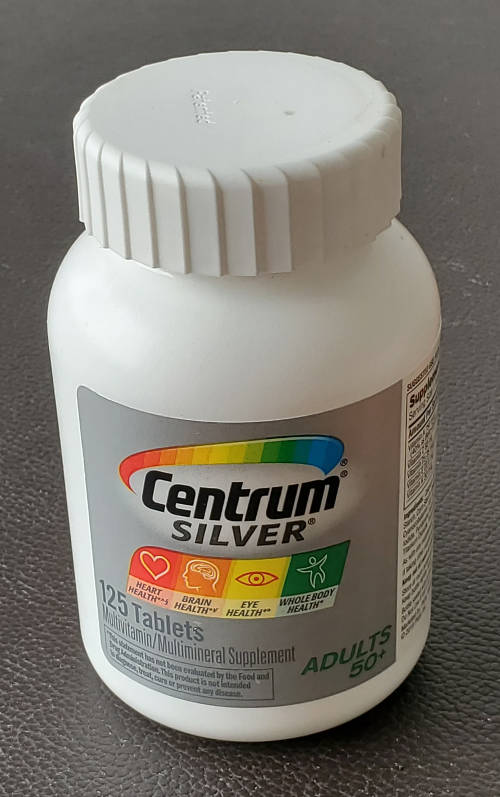
Most daily multivitamins have an ample dose of vitamin A, B, C, D and D as well as essential minerals.
Vitamin D:
Vitamin D deficiency has been found to be linked to an increased risk for Parkinsons disease and is based on a Finish study. Vitamin D potently induces Glial-cell-line Derived Neurotrophic Factor (GDNF) expression where GDNF has been investigated as a treatment for Parkinson's disease as the GDNF protein has been shown to support the survival of dopaminergic neurons. It is believed that a chronic inadequacy of vitamin D leads to the loss of dopaminergic neurons in the substantia nigra region to further Parkinson’s disease progression. Vitamin D is typically produced by the skin when exposed to sunlight (UV-b) but can be supplemented especially when one spends a lot of time indoors. Adequate levels as measured in blood serum are considered to be in the range of 30 to 60 ng/ml (or 75-150 nmol/L). Typically a dose of 1000 IU of vitamin D will raise the blood serum level 5 ng/ml.
Vitamin D comes in two forms: D2 and D3, of which D3 is more effective at improving vitamin D levels in the body.- Vitamin D2 (ergocalciferol) typically plant sourced or found in fortified foods like fortified milk and fortified orange juice
- Vitamin D3 (cholecalciferol) typically animal sourced: fish, liver, eggs and produced by your skin in sunlight (UV-b)
Warning: doses of over 4000 IU/day for the long term are not safe and may cause elevated calcium levels in the blood. Other effects of excessive use include weakness, fatigue, sleepiness, headache, loss of appetite, dry mouth, metallic taste, nausea and vomiting. Vitimin D can make atherosclerosis worse, can lead to kidney stones especially for those with kidney disease. (WebMD)
References:- Serum vitamin D and the risk of Parkinson’s disease
- Vitamin D as an effective treatment approach for drug abuse and addiction
"Vitamin D is a potent inducer of endogenous (produced by the body) GDNF. The most prominent feature of GDNF is its ability to support the survival of dopaminergic neurons."
Foods with high levels of vitamin D include:
| Food | Serving Size | % Recommended Daily Intake |
|---|---|---|
| Salmon | 100 g | 84 % |
| Fortified milk | 16 oz | 32 % |
| Fortified yogurt | 100 g | 7 % |
| Pork chop | 100 g | 5 % |
| One Egg | large | 6 % |
The recommended daily intake of vitamin D is 20 micrograms or 800 IU. Measured levels of vitamin D in blood are healthy when in the range of 30 to 100 ng/mL. The dosage to maintain a healthy blood level of vitamin D will depend on one's metabolism and size.
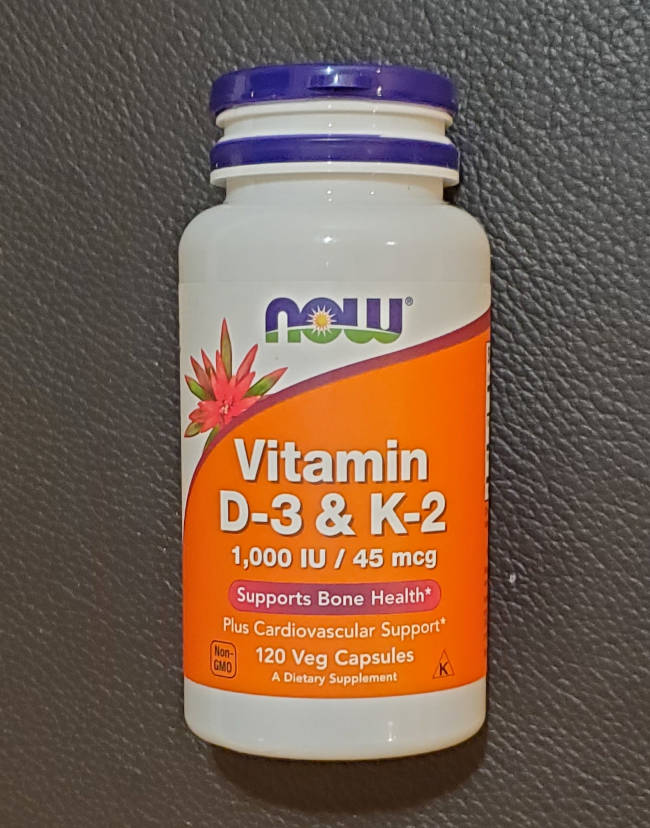
Vitamin D
(Note that vitamin K is often added to support vitamin D in the absorption of calcium)
Calcium D-Glucarate:
The liver is the body's first line of defense against toxins. The liver filters and separates toxins from the blood stream and dumps it into the bile duct which feeds into the gastrointestinal (GI) tract for evacuation. Supplementation of calcium D-glucarate has been shown to help with liver detoxification properties attributed to its ability to excrete, through the biliary and urinary tracts, potentially toxic compounds. Calcium D-glucarate is also known to have anticarcinogenic properties as studied in various animal tumor models including colon, prostate, lung, liver, skin and breast cancer. This supplement is often taken with Glycine for maximum liver detox support. Calcium D-glucarate is a substance produced naturally in small amounts by mammals and is found in many fruits (eg oranges, apples, and grapefruit) and cruciferous vegetables (broccoli, cabbage, and Brussels sprouts). Calcium D-glucarate is also known to lower estrogen and estradiol hormone levels as well as LDL cholesterol in the blood.
This supplement may be of interest to those Parkinson's patients who belive that their's was induced by toxins and thus are in need of detoxification of their liver. The liver has three detox phases of which calcium D-glucarate plays an instrumental role in phase two.
Liver Detox Phases:- enzymes (cytochrome P450s or CYPs) and oxygen convert fat soluble toxins into a water soluble and less toxic form to be eliminated.
- requires amino acids, minerals, vitamin C, bioflavonoids and B vitamins to process and clear toxins. Glutathione (GSH) transferase further processes toxins to be more water-soluble and less toxic to the body.
- transport phase. Byproducts of phase I and II reactions are transported out of the liver cells into the bile duct.
Also see toxins and Parkinson's.
References:- Liver Detox:
- Anticarcinogenic:
- Dietary Glucarate-Mediated Inhibition of Initiation of Diethylnitrosamine-Induced Hepatocarcinogenesis (1992)
- Rikkunshito Ameliorates Cancer Cachexia Partly through Elevation of Glucarate in Plasma (2015)
- Effects of 5-fluorouracil, Leucovorin, and Glucarate in Rat Colon-Tumor Explants (1992)
- Effects of the Experimental Chemopreventative Agent, Glucarate, on Intestinal Carcinogenesis in Rats (1989)
- Dietary D-glucarate effects on the biomarkers of inflammation during early post-initiation stages of benzo[a]pyrene-induced lung tumorigenesis in A/J mice (2011)
- Cholesterol:
Glucuronidation:
Glucuronidation is the body's biological mechanism to process xenobiotic (foreign) substances (pesticides, idustrial compounds, pharmaceutical compounds, dyes, dioxins, etc) into water soluble moloecules for excretion from the body in bile or urine. Glucuronidation is also a primary pathway in the liver's phase 2 detoxification to make toxins hydrophobic (more water soluble) to enable their removal by the kidneys as urine or by the liver as bile through the gastrointestinal tract. Calcium D-Glucarate is a participant and enabler in the glucuronidation process. Calcium D-Glucarate, when ingested, is metabolised to D-glucaric acid (by HCL stomach acid), which can be further metabolised into D-glucaro-1,4-lactone or D-glucaro-6,3-lactone, all of which have important roles in detoxification. Calcium D-Glucarate also inhibits beta-glucuronidase, an enzyme which can disrupt phase 2 detoxification by allowing toxins to be released and reabsorbed rather than be excreted. Thus Calcium D-Glucarate helps the liver excrete toxins and inhibits reabsorbtion.
Also see: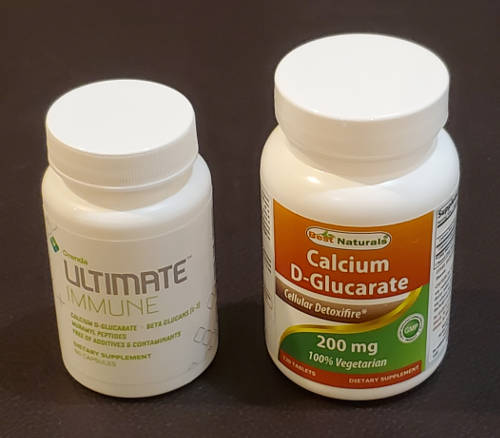
Glycine coupled with Calcium D-Glucarate gives the body extra support for phase 2 of the liver detoxification process. Toxins, especially neurotoxins, are often the root cause of Parkinson's disease and other neurological disorders.
CDP-Choline (Citicoline):
Citicoline makes Levodopa more effective by increasing the density of dopamine receptors and thus allows one to use lower doses of Levodopa and thus reduce Levodopa side effects. Citicoline makes dopamine receptors more sensitive rather than directly stimulating receptors. It takes approximately 30 days for results to become fully apparent. Citicoline is pressent naturally in human tissue and can cross the blood-brain barrier.
Also see:- New strategies in the management of Parkinson's disease: a biological approach using a phospholipid precursor (CDP-choline) (Agnoli et al, 1982)
"CDP-choline treatment showed a significant improvement of rigidity and bradykinesia and a less important amelioration of tremor."
DOI: 10.1159/000117914 - Oxotremorine-induced cholinergic syndrome: modifications by levodopa and/or oral cytidine diphosphocholine (Saligaut et al, 1985)
"Levodopa antagonizes the oxotremorine-induced cerebral symptoms (akinesia + tremor); however this antagonism disappears when mice are chronically pretreated orally with CDP-choline, ..." - Clinical trial on the use of cytidine diphosphate choline in Parkinson's disease (Cubells, Hernando, 1988)
"A significant increase in the number of lymphocytic dopaminergic receptors also occurred." - Citicoline in the treatment of Parkinson's disease (Masso, Urtasun, 1991)
"After 30 days of treatment, the scores on the Columbia rating scale improved 7.3%; rigidity was improved 18.8%; times to walk 10 m and turn over were reduced 17.5% and 37.4%; and the handwriting test scores improved 19.7%. No side effects were reported."

Citicoline
Precursors to Glutathione:
Glutathione (GSH) is the body's first line of defense against toxins and free radicals. GSH can be released by astrocytes, glial cells and by neurons themselves to help defend neurons and within neuron cells from oxidative stress and free radicals. Glutathione is produced within the cells and is used to expel toxins from within the cell. A glutathione oral supplement is not effective for mercury detoxification as it does not survive the digestion tract to be passed into your cells. Instead, supplements which are the precursor or raw ingredients that a cell can use to generate glutathione is preferred.
The three precursors to glutathione are:- N-Acetyl Cysteine (NAC) (amino acid Cysteine with an acetyl group attached to it) Can cross the blood-brain barrier. Not well absorbed oraly.
- Glutamate (found in meat, eggs, dairy and soy sauce) also a neurotransmitter which can induce neuron excitotoxicity
- Glycine (found in high protein foods such as meat and dairy products) also helps form water-soluble compounds which can be excreted more easily (conjugation reaction)
Details of Glutathione synthesis.
Glutathione is known to help the body handle neurotoxins which may be at the root cause of Parkinson's disease and other neurodegenerative conditions. Insufficient levels of glutathione are often found in Parkinson’s disease patients. Glutathione contains sulfur components that to bind mercury in a form that the body can dispose of via bile. When glutathione binds with toxic metals or compounds, it prevents them from binding to cellular proteins and causing damage to both enzymes and tissue. Glutathione also helps prevent mercury from entering cells and causing intracellular damage by binding into a glutathione-mercury complex.
Thomas Jefferson University is conducting a trial using intravenous and oral NAC for its potential to counteract intracellular damage that leads to dopaminergic neuron death and the potential to reduce oxidative damage in Parkinson's Patients. See trial NCT02445651.
Also see Environmental toxins and Parkinson's and Mercury and Parkinson's.
References:- Glutathione – Getting the k'NAC'k of Parkinson's disease overview
- Glutathione:
- Glutathione Metabolism and Parkinson’s Disease (2013) - how glutathione relates to protection of dopaminergic neurons from oxidative damage
- Direct evidence for glutathione as mediator of apoptosis in neuronal cells (1998) - glutathione depletion contribute to neuronal death in Parkinson's disease
- Parkinson's Disease: A Disorder Due to Nigral Glutathione Deficiency? (1982) common feature of neurodegenerative conditions, not just Parkinson's
- Reduced Intravenous Glutathione in the Treatment of Early Parkinson's Disease (1996) Glutathione was administered intravenous twice per day (600 mg each time) for 30 days. All of the participants in this study improved significantly including improvements in resting tremor intensity.
- Liposomal-Glutathione Provides Maintenance of Intracellular Glutathione and Neuroprotection in Mesencephalic Neuronal Cells (Zeevalk, Bernard, Guilford, 2010) PDF
"Cysteine supplementation can replenish GSH, however, elevations in extracellular cysteine can damage neurons via an excitotoxic process. N-acetyl-cysteine (NAC), a derivative of cysteine has been shown in animal studies to provide neuroprotection in an ischemia model and in a 6’OHDA model of Parkinson’s disease ..."
"Consistent with cysteine being the rate limiting amino acid for GSH repletion, cysteine alone was sufficient to replenish intracellular GSH in 4 h. No repletion occurred in the absence of supplements. A similar lack of repletion was found with supplementation with glutamine or glycine in the absence of cysteine ..."
"NAC and ethyl esters of glutathione while effective in repleting and in the case of the ethyl ester, elevating intracellular GSH, have limited usefulness due to potential toxicities. Encapsulation of GSH into lipid vesicles may avoid the potential toxicity to neurons associated with extracellular GSH elevation and may facilitate drug delivery to cells as has been shown for other liposomal preparations."
DOI: 10.1007/s11064-010-0217-0
- N-Acetylcysteine Prevents Loss of Dopaminergic Neurons in the EAAC Mouse (2010) Showed that NAC helped neurons exposed to neurotoxins
- Pharmacokinetics and Bioavailability of Reduced and Oxidized N-acetylcysteine intravenous and oral NAC study
- Pharmacokinetics of N-acetylcysteine in Man (1986) NAC absorption
- Vitamin C, glutathione, or lipoic acid did not decrease brain or kidney mercury in rats exposed to mercury vapor (Aposhian et al, 2003)
"There have been reports about the effectiveness of N-acetyl-cysteine for treating mercury intoxication. In our studies, it neither decreased mean brain nor kidney Hg concentrations. For the brain, NAC appeared to have increased the mercury concentration as compared to saline-treated control rats that inhaled mercury vapor."
DOI: 10.1081/clt-120022000
"Many health practitioners incorrectly advise chlorella, cysteine, NAC and glutathione for chelation, which are not true chelators in the chemical sense, as they do not contain two or more binding groups (dithiol groups). Instead, they contain only one thiol group making them ineffectual chelators, with the capacity to simply move metals around, and cause more problems. These compounds can make matters worse by redistributing stored metals i.e. mobilizing them from their storage sites, but failing to bind and excrete them. This is like stirring up a hornets nest."
Reference: Oral Chelation for Mercury: The Andy Cutler protocol
Note that he prefers his own chelation protocol: ACC
Andy Cutler also states:"If you have elevated cysteine and you want to convert some to glutathione, take a 2:1 weight ratio of glutamine and glycine (e.g. 2,500 mg caps of glutamine with one 500 mg capsule of glycine) and your body will do the rest."
These supplements can be taken on and off rounds, often twice a day suffices. It will be problematic if one is thiol sensitive and consuming thiols. The ACC protocol book, "The Mercury Detoxification Guide", has a section dedicated to thiol food sensitivity. This is the dose Andy stated, but everyone needs to find their own dose.
Glutathione is a thiol with one binder while chelators like DMSA, DMPS and ALA have two and are known as dithiols and cling to mercury more forcefully. Note that DMSA and DMPS act extracellularly (outside the cell) without the ability to pass through the cell membrane to grab mercury from within the cell but can work with glutathione as an intracellular (inside the cell) agent to procure intracellular toxins.
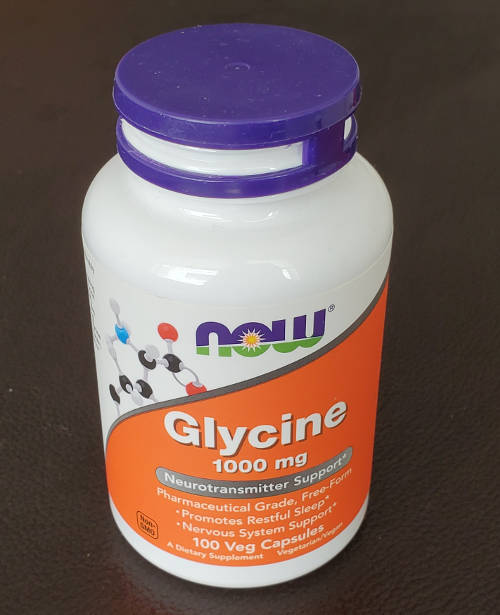
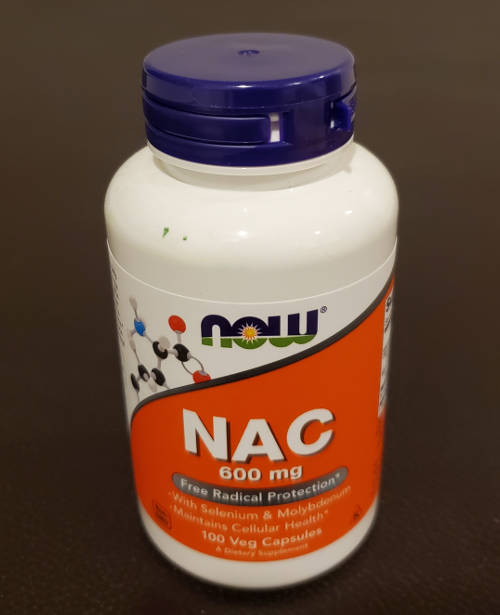
Magnesium:
A lack of magnesium can cause leg cramps, insomnia and fatigue and is also associated with Parkinson's disease. A study published in "Neuropsychiatric Disease and Treatment" found that the supplement Magnesium-L-Thorate elevates the magnesium level in the cerebrospinal fluid, attenuates motor deficits and dopamine neuron loss in a mouse model of Parkinson's disease. The type of magnesium supplement is also important as Magnesium sulfate failed to increase magnesium levels in the cerebrospinal fluid (CSF) and had no effect on neurodegeneration. The magnesium-L-threonate supplement also inhibited inducible nitric oxide synthase (iNOS)-mediated inflammation and oxidative stress.
Foods rich in magnesium include nuts (almonds, cashews, flaxseed, pumpkin seeds), avocados, bananas, beans (lima beans, black beans, Edamame, kidney beans), spinach, Swiss chard, yogurt, dark chocolate and peanuts.
The recommended daily intake of magnesium is at least 432 mg. Measured levels of magnesium in blood are healthy when in the range of 1.5 to 2.5 mg/dL.
Warning: doses greater than 350 mg/day may lead to irregular heartbeat, low blood pressure, confusion, and may build up in the body causing coma and death (WebMD)
References: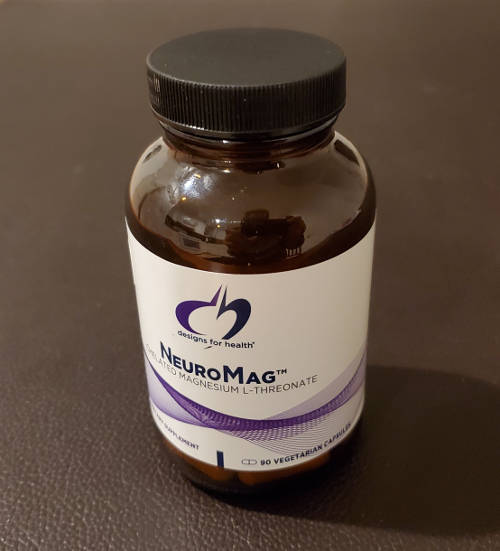
Magnesium L_Threonate
Omega-3:
Study suggests that dietary intake exerts neuroprotective actions in an animal model of Parkinsonism. Omega-3 also potentially thwarts Arteriosclerosis and the potential for Arteriosclerotic Parkinsonism caused by micro-strokes or blood vessle restriction. Omega-3 fatty acid, DHA, also has been found to reduce levodopa induced dyskinesia. A primate study found that a very high dosage of 5 g DHA/70 kg (154 lbs) per day resulted in a 50% reduction in levodopa-induced dyskinesia after 30 days. Dr. Laurie Mischley ND PhD found similar success in some of her patients using 4 g (1 tbsp)/day of fish oil supplement.
If the omega-3 oil is derived from fish, it is likely that there will be a mercury (and possibly a PCB) contamination problem unless the omega-3 oil has been molecularly distilled. It is also helpful if it was derived from short lived fish, low on the food chain, such as sardines.
References:- Beneficial effects of dietary omega-3 polyunsaturated fatty acid on toxin-induced neuronal degeneration in an animal model of Parkinson's disease (2008)
DOI: 10.1096/fj.07-9677com - Docosahexaenoic acid reduces levodopa‐induced dyskinesias in 1‐methyl‐4‐phenyl‐1,2,3,6‐tetrahydropyridine monkeys (2006)
DOI: 10.1002/ana.20738 - Omega-3 fatty acids' supplementation in Parkinson's disease: A systematic review of randomized controlled trials (P. Detopoulou, 2024)
DOI: 10.1016/j.nutos.2024.03.007
"Three randomized controlled trials (RCTs) investigated the effects of omega-3 fatty acids on the progression of PD with the use of Unified Parkinson's Disease Rating Stage (UPDRS) score, and all showed beneficial effects."
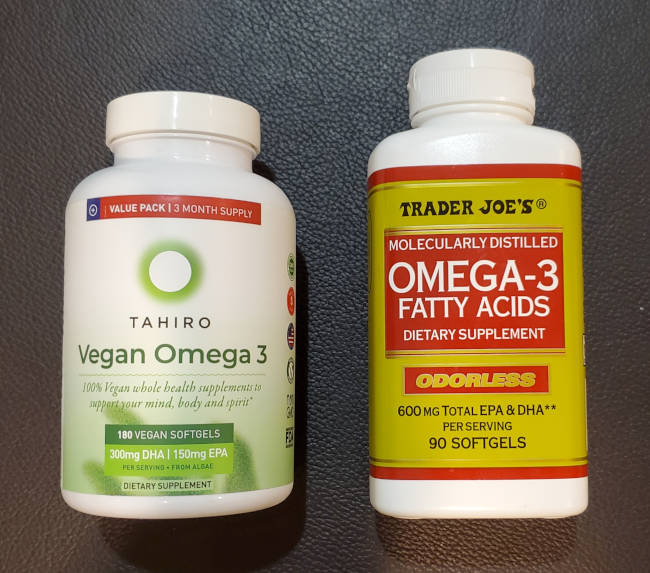
Omega-3 sourced from vegetables or fish.
Saffron:
Saffron (Crocus sativus) and its active ingredients Crocin and Safranal have been shown to be neuro-protective of dopaminergic cells, improve dopamine levels and an anti-inflammatory. Unfortunaely much of the research has been on fruit flies and lab rats. Effective dosage has not been determined.
References:
- Evidence of neuroprotective effects of saffron and crocin in a Drosophila model of parkinsonism (Rao et al, 2016)
"the neuroprotective effects of saffron and crocin in the fly model may be largely attributable to its antioxidant action"
"... we propose that saffron may be exploited as a supplementary therapeutic agent in PD and other oxidative stress mediated neurodegenerative conditions"
DOI: 10.1016/j.neuro.2015.12.010 - Widespread brain transcriptome alterations underlie the neuroprotective actions of dietary saffron (Skladnev et al, 2016)
"Dietary saffron has shown promise as a neuroprotective intervention in clinical trials of retinal degeneration and dementia and in animal models of multiple CNS disorders, including Parkinson's disease."
"Transcriptomic studies reveal that saffron treatment influences the expression of a range of genes in the brain, with a down-regulation of pathways relating to cell death and up-regulation of pathways relating to cell proliferation and migration, cytokine signaling and intercellular dynamics."
"enhancement of BBB integrity may be one mechanism by which saffron pre-treatment provides neuroprotection."
"Another avenue for further research is to investigate whether saffron or its constituents cross the BBB and enter the brain, or whether saffron instead stimulates systemic mediators that transduce protective effects to the brain."
DOI: 10.1111/jnc.13857 - Crocin protects PC12 cells against MPP(+)-induced injury through inhibition of mitochondrial dysfunction and ER stress (Zang, Chao, 2015)
DOI: 10.1016/j.neuint.2015.07.011 - Antiinflammatory, Antioxidant, and Immunomodulatory Effects of Crocus sativus L. and its Main Constituents (Boskabady and Farkhondeh, 2016)
DOI: 10.1002/ptr.5622 - Effects of saffron and its constituents, crocin-1, crocin-2, and crocetin on α-synuclein fibrils (Inoue et al, 2018)
DOI: 10.1007/s11418-017-1150-1
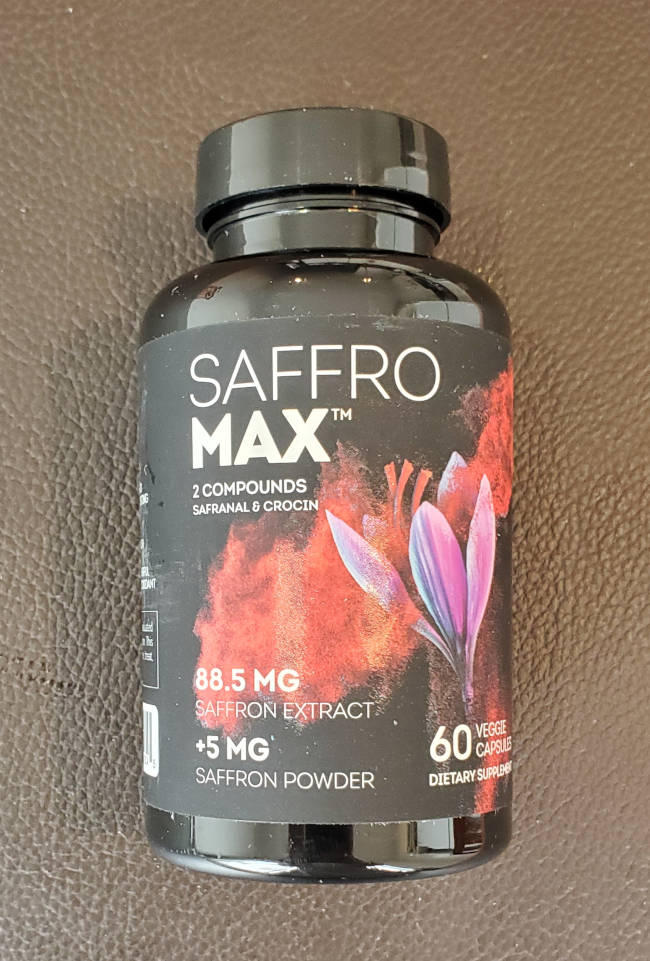
Blood Testing for Vitamins and Minerals:
These services often require a doctor's order for a test.
- Quest Diagnostics 1-800-277-8772
- GDX Diagnostics
- Doctor's Data Inc: global
hair, blood, stool, urine - Labcorp:
full spectrum of tests
Testing Requisitions:
These services provide a doctor's order for a test.
- Private MD Labs:
Supports Labcorp or Quest lab tests - Direct Labs: global. Provides doctors orders for tests
- Accesa Labs:
- Your Lab Work: US (New Jersey, New York, Maryland, and Rhode Island excluded)
- My Labs for Life:
Supports Quest lab tests
Ketogenic Diet:
The ketogenic diet is a high-fat, adequate-protein, low-carbohydrate diet which forces the body to burn fats rather than carbohydrates and its glucose derivative. Normally brain function is fueled by consumption of glucose. During a ketogenic diet, fats are converted to keytones and replace glucose as an energy source for the brain. When the body enters this state, it is said to be in a state of ketosis. While of primary benefit for those wanting to lose weight or suffering from epilepsy, it has been found to be helpful in non-motor functions for people suffering from neurological disorders such as Alzheimer's, ALS and Parkinson's disease. A ketogenic diet may actually lead to an "intermittent exacerbation of the PD tremor and/or rigidity". Unfortunately the study was on a small sample size.
References:- Low-fat versus ketogenic diet in Parkinson's disease: A pilot randomized controlled trial. (2018)
- Treatment of Parkinson disease with diet-induced hyperketonemia: a feasibility study (2006)
Also see intermittent fasting and autophagy.
Gluten Free Diet:
Those with celiac disease can not process gluten and must conform to a gluten free diet. Gluten free diets have also become recently popular in an attempt to consume a low inflammation diet. A correlation has been found in a study linking gluten free diets with toxic metal bioaccumulation. This may be attributed to the use of rice flour as a substitute for wheat flour containing gluten. Rice grown in Texas and other Southern stated is known to contain arsenic due to its use in past times as a pesticide in cotton fields. Over the years there has been a crop rotation from cotton to rice and rice grown in this soil readily absorbs the arsenic.
Gluten free diets have also embraced foods like fish, known to host mercury.
References:- Accumulation of Heavy Metals in People on a Gluten-Free Diet (Raehsler et al 2018)
NLRP3 Inflammation Pathway Inhibitors:
NLRP3 is a component of macrophage immune cells (white blood cells which engulf and consume foreign substances) which react to stress and generate "inflammasome" which in turn contains a receptor protein (ASC) that encourages activities (autoinflammatory and autoimmune conditions) which lead to pyroptosis (cell death) and the flood of inflammation factors. Alpha-synuclein aggregates have been shown to promote inflammasome activation in brain microglia (brain immune macrophage cells, main form of immune defense in the central nervous system). Foods which inhibit this pathway, inhibit the progression of Parkinson's.
Also see:Melatonin has been shown to be an important antioxidant and also an anti-inflammatory molecule which work against the activation of the inflammasomes and, in particular, of the NLRP3 inflammasome. While many of the current anti-inflammatory drugs have significant side effects, melatonin is an uncommonly safe molecule when taken as a supplement. While safe, it is recommended that no more than 6 mg be taken in a 24 hour period as higher doses can suppress cortisol production from the adrenal glands, leading to adrenal fatigue.
Warning: Melatonin can make depression, diabetes, blood pressure and seizure disorders worse. May also interfere with immunosuppressive therapies (WebMD). Melatonin also regulates the circadian rhythm, so the time of dosage matters and should be taken an hour before the start of the sleeping cycle. Drugs which can cause the depletion of melatonin include NSAIDS (Non-Steroidal Anti-Inflammatory Drugs) like aspirin and ibuprofen, antidepressants, betablockers and medications containing estrogen.
References: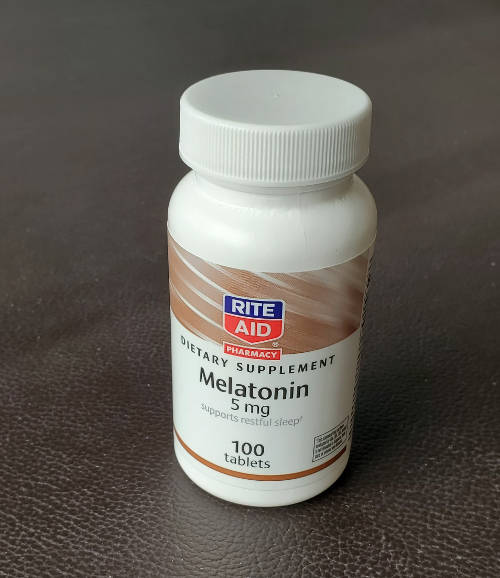
Melatonin: an NLRP3 inflamation inhibitor
Foods and supplements which inhibit NLRP3:
Inhibition of NLRP3 is not only good for limiting the facilitation and instigation of Parkinson's disease progression but also that of Alzheimer's disease.
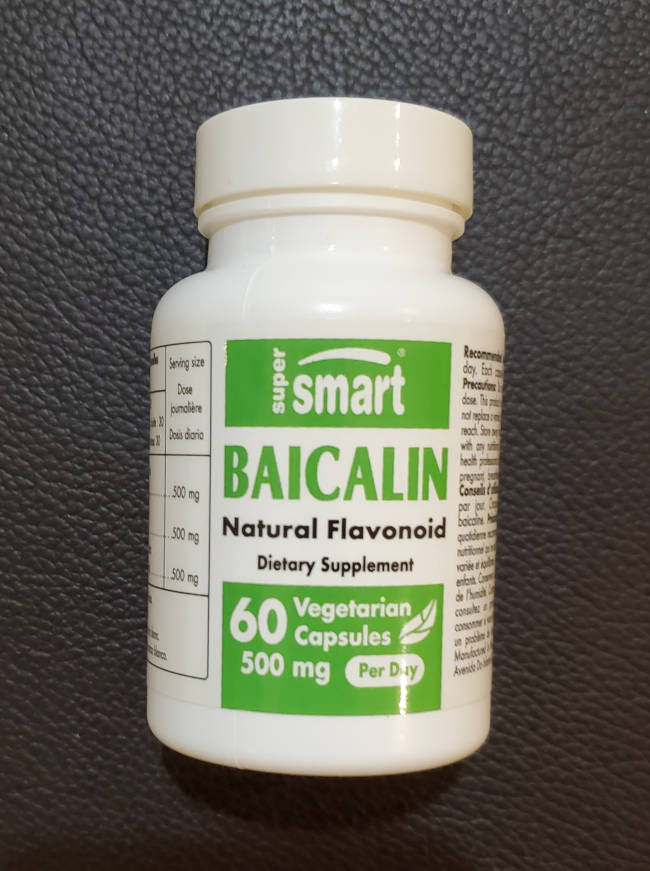
Baicalein: an NLRP3 inflamation inhibitor which has shown efficacy in Parkinson's mouse models.
Restore Gold:
This supplement contains vitamins and compounds claimed to have neuroprotective and restorative characteristics to help Parkinson's patients. They claim to acheive this by combating oxidative stress which causes mitochondrial dysfunction, support for mitophagy to supress Lewy body formation and free radical resistance to supress neural inflammation.
Restore Gold contains the following:- Acetyl-L-Carnitine (100 mg): brain energy management and mitochondrial function
- Alpha Lipoic Acid (100 mg): contributes to xenobiotic detoxification and antioxidant protection
- Grape Seed Extract (60 mg): alleviate neurodegeneration in Parkinson’s via enhancement of mitochondrial function and may inhibit toxic alpha-synuclein aggregation
- Green Tea Extract (100 mg): neuroprotectant
- L-Tyrosine (400 mg): increase dopamine turnover in patients
- N-Acetyl-Cysteine (NAC) (400 mg): precursor in the cellular production of glutathione, the body's natural antioxidant and detoxification agent
- Tauroursodeoxycholic acid (TUDCA) (300 mg): restore mitochondrial function
Note that this product contains a substantial dose of ALA, a known chelator of mercury. Their recommended dosage of four capsules a day puts the ALA dosage at 400 mg per day. The Dr. Andy Cutler Chelation (ACC) protocol would consider it unwise to use this product if one has silver-mercury amalgam dental fillings as ALA would pull mercury from the amalgam fillings exposing the patient to mercury toxicity and an increased burden. Restore Gold also includes 400 mg of NAC per capsule, a precursor to glutathione which is also a chelator of mercury. If one experiences an uncomfortable brain fog or the effects of mercury toxicity, it might be wise to avoid using this product. It is clear that this product attempts to detoxify the body but this might be a dangerous endeavor for those with a high toxic metal burden. For more on mercury, chelation, dental amalgam removal and ALA see Parkinson's and mercury.
Also see: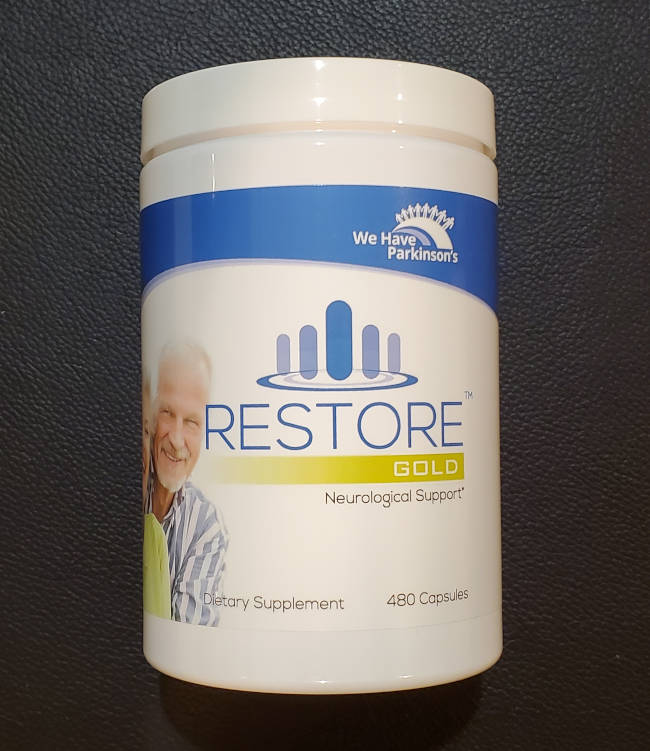
Restore Gold
List of Essential Micronutrients:
- Biotin
- Folic Acid
- Niacin
- Pantothenate
- Riboflavin
- Thiamine
- Vitamin A
- Vitamin B6
- Vitamin B12
- Vitamin C
- Vitamin D
- Vitamin E
- Vitamin K
- Calcium
- Chloride
- Chromium
- Cobalt
- Copper
- Iodine
- Iron
- Magnesium
- Manganese
- Molybdenum
- Phosphorus
- Potassium
- Selenium
- Sodium
- Zinc
- Linolenic acid/DHA (Omega 3)
- Linolenic acid (Omega 6)
- Isoleucine
- Leucine
- Lysine
- Methionine
- Phenylalanine
- Threonine
- Tryptopohan
- Valine
- Histidine
- Choline
Pros:
- Some vitamins and supplements have been shown to be a positive treatment for Parkinson's especially if one is deficient. Supplementation is based on an individual's personal genetics, deficiencies, allergies and disease manifestation.
Cons:
- Many vitamin supplements are completely unnecessary for those who choose their food wisely. While fiber supplements are effective at relieving constipation and are assuredly an improvement of Parkinson's symptoms, they are not likely to effect the progression of Parkinson's. While shown to be healthy, the ketogenic diet is unlikely to have a profound effect on Parkinson's symptoms as it was only found to be helpful for non-motor symptoms and perhaps an "intermittent exacerbation of the PD tremor and/or rigidity" (ref).
- Impurities such as lead, arsenic and mercury have been commonly found in herbal remedies. Of 260 over-the-counter California herbal remedies, 32% had undeclared ingredients.
China and India sourced compounds are often derived from plants grown from polluted soil with polluted irrigation water.
(ref)
% of samples PPM (USP limit 30) Lead 9.6% 54.9 ppm Arsenic 14.3% 14,000 ppm Mercury 13.9% 1,046 ppm